Development Path of the People–Land–Food Complex System in Xinjiang from the Dual Perspectives of Adaptability and Obstacle Degree
Abstract
1. Introduction
2. Theoretical Foundation
2.1. Research Framework
2.2. Elemental Adaptation Relationship Structure of the P-L-F Complex System
2.3. Evaluation Indicator System
3. Materials and Methods
3.1. Overview of the Study Area
3.2. Data Sources
3.3. Research Methods
3.3.1. Variance Inflation Factor
3.3.2. Min–Max Normalization
3.3.3. Entropy Weight Method
3.3.4. Comprehensive Adaptability Evaluation Model
- (1)
- Adaptability Quantification Model
- (2)
- Compatibility Quantification Modelwhere represents the matching degree for the j-th year; are the differences in the ordered sequences of x, y, and z values from smallest to largest. This study uses the average of the dual matching degrees of P-L-F to calculate the overall matching status of the three systems. U represents the number of study units.
- (3)
- Comprehensive Adaptability Weighted Calculationwhere represents the adaptability; a and b are the weights assigned to adaptability and matching degree, respectively. Since compatibility only reflects the symmetrical relationship between systems and does not indicate that the systems are in a good development state, the importance of compatibility is lower than that of adaptability. Based on existing research, we set a, b are the weights of adaptability and compatibility, respectively. Since compatibility only reflects the symmetrical relationship between systems and does not indicate that the systems are in a good development state, the importance of compatibility is lower than that of adaptability. Based on existing research [50,51], we set a = 0.6, b = 0.4. Adaptability is classified into five levels based on the Gini coefficient: extremely incompatible, incompatible, moderately compatible, relatively compatible, and highly compatible.
3.3.5. Obstacle Degree Model
4. Results
4.1. Spatiotemporal Characteristics of the Comprehensive Level of the Xinjiang P-L-F System
4.2. Assessment of the Adaptability of the Xinjiang P-L-F Composite System
4.3. Adaptability of the Xinjiang P-L-F Dual System
4.4. Diagnosis of Obstacle Factors
5. Discussion
5.1. Focusing on the Dynamic Development of the P-L-F System in Xinjiang
5.2. Promoting the Adaptability Transition of the Complex and Dual Systems
5.3. Analyzing the Barrier Factors of the Complex System’s Adaptability
5.4. Limitations and Outlook
6. Conclusions
Author Contributions
Funding
Data Availability Statement
Acknowledgments
Conflicts of Interest
Abbreviations
| P-L-F | People–Land–Food |
| P-L | People–Land |
| P-F | People–Food |
| L-F | Land–Food |
| VIF | Variance Inflation Factor |
References
- Fei, L.; Shuang, M.; Xiaolin, L. Changing Multi-Scale Spatiotemporal Patterns in Food Security Risk in China. J. Clean. Prod. 2023, 384, 135618. [Google Scholar] [CrossRef]
- Godfray, H.C.J.; Beddington, J.R.; Crute, I.R.; Haddad, L.; Lawrence, D.; Muir, J.F.; Pretty, J.; Robinson, S.; Thomas, S.M.; Toulmin, C. Food Security: The Challenge of Feeding 9 Billion People. Science 2010, 327, 812–818. [Google Scholar] [CrossRef]
- Kong, X. China Must Protect High-Quality Arable Land. Nature 2014, 506, 7. [Google Scholar] [CrossRef]
- Liang, X.Y.; Jin, X.B.; Sun, R.; Han, B.; Ren, J.; Zhou, Y.K. China’s Resilience-Space for Cultivated Land Protection under the Restraint of Multi-Scenario Food Security Bottom Line. Acta Geogr. Sin. 2022, 77, 697–713. [Google Scholar]
- Chen, H.; Tan, Y.; Xiao, W.; He, T.; Xu, S.; Meng, F.; Li, X.; Xiong, W. Assessment of Continuity and Efficiency of Complemented Cropland Use in China for the Past 20 Years: A Perspective of Cropland Abandonment. J. Clean. Prod. 2023, 388, 135987. [Google Scholar] [CrossRef]
- Zhang, J. Regional Differences in China’s Man-Food Nexus and National Food Security. Econ. Geogr. 2009, 29, 1894–1897+1917. [Google Scholar]
- Verburg, P.H.; Mertz, O.; Erb, K.-H.; Haberl, H.; Wu, W. Land System Change and Food Security: Towards Multi-Scale Land System Solutions. Curr. Opin. Environ. Sustain. 2013, 5, 494–502. [Google Scholar] [CrossRef]
- Liu, Y.X.; Fu, B.J.; Wang, S.; Li, Y.; Zhao, W.; Li, C. A Review of Research on Water-Food-Ecology Linkages in Coupled Human-Land Systems in Dry Areas. J. Geogr. Sci. 2021, 40, 541–555. [Google Scholar]
- Yin, R.; Wang, Z.; Xu, F. Multi-Scenario Simulation of China’s Dynamic Relationship between Water–Land Resources Allocation and Cultivated Land Use Based on Shared Socioeconomic Pathways. J. Environ. Manag. 2023, 341, 118062. [Google Scholar] [CrossRef] [PubMed]
- Yang, W.Z.; Guo, S.; Yu, L.; Zhang, P. Spatiotemporal Variation of Coordinated Development Relationship between Population, Cultivated Land and Grain in Cangzhou City. Res. Soil Water Conserv. 2016, 23, 253–259. [Google Scholar]
- He, Y.Q.; Yi, X.; Pan, X.Y.; Qian, S. Spatial-Temporal Evolution of Coordination Degree of the Compound System among the Population, Cultivated Land and Grain in the Yangtze River Economic Zone. J. Nanchang Univ. Nat. Sci. 2016, 40, 381–388. [Google Scholar]
- Radwan, T.M.; Blackburn, G.A.; Whyatt, J.D.; Atkinson, P.M. Dramatic Loss of Agricultural Land Due to Urban Expansion Threatens Food Security in the Nile Delta, Egypt. Remote Sens. 2019, 11, 332. [Google Scholar] [CrossRef]
- Prăvălie, R.; Patriche, C.; Borrelli, P.; Panagos, P.; Roșca, B.; Dumitraşcu, M.; Nita, I.-A.; Săvulescu, I.; Birsan, M.-V.; Bandoc, G. Arable Lands under the Pressure of Multiple Land Degradation Processes. A Global Perspective. Environ. Res. 2021, 194, 110697. [Google Scholar] [CrossRef]
- Berchin, I.I.; Nunes, N.A.; de Amorim, W.S.; Zimmer, G.A.A.; da Silva, F.R.; Fornasari, V.H.; Sima, M.; de Andrade, J.B.S.O. The Contributions of Public Policies for Strengthening Family Farming and Increasing Food Security: The Case of Brazil. Land Use Policy 2019, 82, 573–584. [Google Scholar] [CrossRef]
- Mahmood, Z.; Iftikhar, S.; Saboor, A.; Khan, A.U.; Khan, M. Agriculture Land Resources and Food Security Nexus in Punjab, Pakistan: An Empirical Ascertainment. Food Agric. Immunol. 2016, 27, 52–71. [Google Scholar] [CrossRef]
- Ma, N.; Li, X. Study on Spatial and Temporal Changes of Cultivated Land Utilization and Food Security Guarantee in Ningbo City. Master’s Thesis, Zhejiang Gongshang University, Hangzhou, China, 2023. [Google Scholar]
- Nath, R.; Luan, Y.; Yang, W.; Yang, C.; Chen, W.; Li, Q.; Cui, X. Changes in Arable Land Demand for Food in India and China: A Potential Threat to Food Security. Sustainability 2015, 7, 5371–5397. [Google Scholar] [CrossRef]
- Molotoks, A.; Smith, P.; Dawson, T.P. Impacts of Land Use, Population, and Climate Change on Global Food Security. Food Energy Secur. 2021, 10, e261. [Google Scholar] [CrossRef]
- Feng, Z.; Li, X. Strategies for Arable Land and Food Security: Hiding Food in the Soil and Improving the Comprehensive Production Capacity of China’s Land Resources. Geogr. Territ. Res. 2000, 16, 1–5. [Google Scholar]
- Tan, S.; Hu, B.; Kuang, B.; Zhou, M. Regional Differences and Dynamic Evolution of Urban Land Green Use Efficiency within the Yangtze River Delta, China. Land Use Policy 2021, 106, 105449. [Google Scholar] [CrossRef]
- Horvat, A.; Behdani, B.; Fogliano, V.; Luning, P.A. A Systems Approach to Dynamic Performance Assessment in New Food Product Development. Trends Food Sci. Technol. 2019, 91, 330–338. [Google Scholar] [CrossRef]
- Akinbode, S.O.; Dipeolu, A.O.; Bolarinwa, T.M.; Olukowi, O.B. Effect of Health Outcome on Economic Growth in Sub-Saharan Africa: A System Generalized Method of Moment Approach. J. Econ. Dev. 2021, 23, 254–266. [Google Scholar] [CrossRef]
- Roer, A.-G.; Korsaeth, A.; Henriksen, T.M.; Michelsen, O.; Strømman, A.H. The Influence of System Boundaries on Life Cycle Assessment of Grain Production in Central Southeast Norway. Agric. Syst. 2012, 111, 75–84. [Google Scholar] [CrossRef]
- Wang, X.; Qiang, W.; Niu, S.; Growe, A.; Yan, S.; Tian, N. Multi-Scenario Simulation Analysis of Grain Production and Demand in China during the Peak Population Period. Foods 2022, 11, 1566. [Google Scholar] [CrossRef]
- Li, W.; Li, Y.; Zhao, Y.; Zhu, Y.; Li, Y.; Song, Q.; Jiang, S.; Xing, X.; Wang, H.; Liu, K. Multidimensional Evolution Analysis of Water-Energy-Food Nexus System—Taking Beijing-Tianjin-Hebei Region as an Example. China Water Resour. 2025, 2025, 1–13. [Google Scholar]
- Shi, M.; Wu, H.; Jiang, P.; Zheng, K.; Liu, Z.; Dong, T.; He, P.; Fan, X. Food-Water-Land-Ecosystem Nexus in Typical Chinese Dryland under Different Future Scenarios. Sci. Total Environ. 2023, 880, 163183. [Google Scholar] [CrossRef] [PubMed]
- Mao, D.; Wang, Z.; Wu, B.; Zeng, Y.; Luo, L.; Zhang, B. Land Degradation and Restoration in the Arid and Semiarid Zones of China: Quantified Evidence and Implications from Satellites. Land Degrad. Dev. 2018, 29, 3841–3851. [Google Scholar] [CrossRef]
- Wiemer, C. The Economy of Xinjiang. In Xinjiang; Routledge: Abingdon-on-Thames, UK, 2015; pp. 163–189. [Google Scholar]
- Gao, X.; Liu, J.; Wen, Y.; Lin, H.; Liang, Y.; Liu, M.; Zhou, Z.; Zhang, J.; Wang, Z. Estimating Future Climate Change Impacts on Wheat Yield and Water Demand in Xinjiang, Northwest China Using the DSSAT-CERES-Wheat Model. Comput. Electron. Agric. 2025, 237, 110604. [Google Scholar] [CrossRef]
- Chartres, C.J.; Noble, A. Sustainable Intensification: Overcoming Land and Water Constraints on Food Production. Food Secur. 2015, 7, 235–245. [Google Scholar] [CrossRef]
- Ma, W.; Jiang, G.; Li, W.; Zhou, T. How Do Population Decline, Urban Sprawl and Industrial Transformation Impact Land Use Change in Rural Residential Areas? A Comparative Regional Analysis at the Peri-Urban Interface. J. Clean. Prod. 2018, 205, 76–85. [Google Scholar] [CrossRef]
- Bao, C.; Fang, C. Dynamic Analysis on the Cultivated Area-Food-Population Complex System in the Yangtze River Basin and Its Control Approaches. Chin. J. Popul. Resour. Env. 2007, 17, 115–120. [Google Scholar]
- He, C.; Liu, Z.; Xu, M.; Ma, Q.; Dou, Y. Urban Expansion Brought Stress to Food Security in China: Evidence from Decreased Cropland Net Primary Productivity. Sci. Total Environ. 2016, 576, 660–670. [Google Scholar] [CrossRef]
- Wang, S.; Kong, W.; Ren, L.; Zhi, D. Research on Misuses and Modification of Coupling Coordination Degree Model in China. J. Nat. Resour. 2021, 36, 793–810. [Google Scholar] [CrossRef]
- Liu, Z.W.; Zheng, Y.; Li, Z.H.; Zhang, S.; Yang, H.; Sang, X. Evaluation on Water Resources- Economy-Population Matching Degree from Perspective of Spatial Equilibrium. Yangtze River 2023, 54, 31–39. [Google Scholar]
- Toops, S.W. The Ecology of Xinjiang: A Focus on Water. In Xinjiang; Routledge: Abingdon-on-Thames, UK, 2015; pp. 264–275. [Google Scholar]
- Ridwan, R.; Ismail, M. Population Growth Has an Impact on The Economy and Food Availability. J. Posthumanism 2025, 5, 2819–2827. [Google Scholar] [CrossRef]
- Alexandratos, N. Countries with Rapid Population Growth and Resource Constraints: Issues of Food, Agriculture, and Development. Popul. Dev. Rev. 2005, 31, 237–258. [Google Scholar] [CrossRef]
- Shah, F.; Wu, W. Soil and Crop Management Strategies to Ensure Higher Crop Productivity within Sustainable Environments. Sustainability 2019, 11, 1485. [Google Scholar] [CrossRef]
- Feng, Y.; Fanghui, Y.; Li, C. Improved Entropy Weighting Model in Water Quality Evaluation. Water Resour. Manag. 2019, 33, 2049–2056. [Google Scholar] [CrossRef]
- Raczka, W. Xinjiang and Its Central Asian Borderlands. Cent. Asian Surv. 1998, 17, 373–407. [Google Scholar] [CrossRef]
- Hu, J.; Song, M.; Zhang, L. Spatial and Temporal Evolution of Land Use Carbon Emission and Carbon Balance Zoning: Evidence from Xinjiang China. Sci. Rep. 2025, 15, 35705. [Google Scholar] [CrossRef]
- Qi, Y.K. Analysis of the Measurement and Evolutionary Characteristics of the Coordination Level Between Population, Economy, Resources, and Environment in Xinjiang. J. YiLi Prefect. Communist Party Inst. 2024, 4, 57–61. [Google Scholar]
- Vu, D.H.; Muttaqi, K.M.; Agalgaonkar, A.P. A Variance Inflation Factor and Backward Elimination Based Robust Regression Model for Forecasting Monthly Electricity Demand Using Climatic Variables. Appl. Energy 2015, 140, 385–394. [Google Scholar] [CrossRef]
- Liu, X.W. The Impact of Macroeconomic Indicators on Average Employee Wages. Master’s Thesis, Dongbei University of Finance and Economics, Dalian, China, 2016. [Google Scholar]
- Zhao, J.; Deng, C.J.; Li, W.L. Evaluation of Degradation Levels in the Bayinbuluke Grassland, Tianshan Mountains, Xinjiang, Over the Past 35 Years. Arid Zone Res. 2023, 40, 636–646. [Google Scholar]
- Ma, X.F.; Hu, S.L. Spatiotemporal Adaptation Characteristics and Influencing Factors of Tourism City Resilience and Residents’ Happiness Level: Taking Zhangjiajie City as an Example. Resour. Sci. 2022, 44, 2373–2385. [Google Scholar] [CrossRef]
- Tong, H.D.; Jun, F.C. Evaluation and Obstacle Factors of Coordination Development of Regional Water-Energy-Food-Ecology System under Green Development: A Case Study of Yangtze River Economic Belt, China. Stoch. Environ. Res. Risk Assess. 2022, 36, 2477–2493. [Google Scholar] [CrossRef]
- Yang, Y.; Fan, M. Analysis of the Spatial-Temporal Differences and Fairness of the Regional Energy Ecological Footprint of the Silk Road Economic Belt (China Section). J. Clean. Prod. 2019, 215, 1246–1261. [Google Scholar] [CrossRef]
- Xiang, L.G.; Cheng, P.L.; Qi, F.; Wei, L. Adaptability Investigation of Water Ecological Security and Socio-Ecological Resilience in Arid Inland River Basins, China. Environ. Sustain. Indic. 2025, 27, 100859. [Google Scholar] [CrossRef]
- Wang, Z.F.; Zhang, X.T. Evaluation of the Suitability and Impact of Human-Land-Food Composite Systems in China. Acta Geogr. Sin. 2024, 79, 779–799. [Google Scholar]
- Abulimiti, M.; Simayi, Z.; Yang, S.; Chai, Z.; Yan, Y. Study of Coordinated Development of County Urbanization in Arid Areas of China: The Case of Xinjiang. PLoS ONE 2022, 17, e0276235. [Google Scholar] [CrossRef] [PubMed]
- Li, X.; Chen, Y.; Xu, L.; Li, P.; Zhang, R. Transformation of Farmland Use and Driving Mechanism in Xinjiang since China’s Western Development Policy. Front. Ecol. Evol. 2022, 10, 942065. [Google Scholar] [CrossRef]
- Gu, H.X.; Gu, H.X.; Chen, H. Research on Over a Decade of Development and Future Prospects in the Core Area of the Belt and Road Initiative: With a Discussion on Coordinating the High-Quality Development of China (Xinjiang) Pilot Free Trade Zones. J. Jianghan Univ. Soc. Sci. Ed. 2024, 41, 89–103. [Google Scholar]
- Xu, X.; Wang, Y.Y. Measurement of Rural Revitalization Levels and Analysis of Influencing Factors in the New Era of Western Development. J. Southwest Univ. Natl. Humanit. Soc. Sci. Ed. 2021, 42, 129–137. [Google Scholar]
- Chen, H.M.; Yang, J.F.; Xue, Z.; Li, Q. Comprehensive Evaluation and Heterogeneity Analysis of High-Quality Agricultural Development in Xinjiang. J. Anhui Agric. Sci. 2024, 52, 261–264. [Google Scholar]
- Wei, B.; Kasimu, A.; Fang, C.; Reheman, R.; Zhang, X.; Han, F.; Zhao, Y.; Aizizi, Y. Establishing and Optimizing the Ecological Security Pattern of the Urban Agglomeration in Arid Regions of China. J. Clean. Prod. 2023, 427, 139301. [Google Scholar] [CrossRef]
- Zhang, Y.; Kasimu, A.; Zhang, X.; Song, N.; Shayiti, B.; An, X. Spatiotemporal Decoupling of Urban Expansion Intensity and Land Use Efficiency in Arid Oasis Agglomerations. Land 2025, 14, 2143. [Google Scholar] [CrossRef]
- Zhao, R.; Fang, C.; Liu, J.; Zhang, L. The Evaluation and Obstacle Analysis of Urban Resilience from the Multidimensional Perspective in Chinese Cities. Sustain. Cities Soc. 2022, 86, 104160. [Google Scholar] [CrossRef]
- Xiao, Q.S.; Wang, Y.Z. Characteristics of Spatial and Temporal Variability of NPP of Arable Land in the Main Grain-Producing Areas (Henan Province) and Analysis of Influencing Factors. Environ. Sci. 2024, 46, 3632–3644. [Google Scholar]
- Song, N.; Kasimu, A.; Tang, L.; Chen, J.; Zhang, Y.; An, X.; Zhang, X. A Network Perspective on Ecosystem Service Trade-Offs and Synergies Relationships and Their Spatial Pattern Optimization in Arid Regions. Environ. Technol. Innov. 2025, 40, 104584. [Google Scholar] [CrossRef]
- Qin, H.T. Study on the Carrying Capacity of Cultivated Land in Arid Areas Based on the Human-Food Relationship—Taking Gansu Province as an Example. J. Gansu Agric. 2023, 7, 25–30. [Google Scholar]
- Wang, T.; Yang, Z.; Han, F.; Yu, J.; Ma, X.; Han, J. Assessment of Tourism Socio-Ecological System Resilience in Arid Areas: A Case Study of Xinjiang, China. Ecol. Indic. 2024, 159, 111748. [Google Scholar] [CrossRef]
- Xia, N.; Hai, W.; Tang, M.; Song, J.; Quan, W.; Zhang, B.; Ma, Y. Spatiotemporal Evolution Law and Driving Mechanism of Production–Living–Ecological Space from 2000 to 2020 in Xinjiang, China. Ecol. Indic. 2023, 154, 110807. [Google Scholar] [CrossRef]
- Sun, Q.X.; Zhang, W.X. Impacts of Agricultural Land Use Changes on Ecosystem Service Values—A Case Study of Altay Region, Xinjiang. South-Cent. Agric. Sci. Technol. 2023, 44, 124–128. [Google Scholar]
- Jiang, S.G.; Hu, B.H. Measuring the Spatial Evolution of Cultivated Land Resources and Water Resources in Arid Zones—Taking Xinjiang as an Example. Water Resour. Dev. Res. 2023, 23, 26–32. [Google Scholar]
- He, J.; Ju, X.; Han, C.; Liu, L.; Zhang, H.; Adilai, S.; Li, C. Spatiotemporal Dynamics and Driving Mechanism of Eco-Environmental Quality in Piedmont-Oasis-Desert Ecotone Based on Long-Term Harmonized Remote Sensing Ecological Index-Take Korla-Tiemenguan Oasis in Xinjiang as an Example. Environ. Sustain. Indic. 2025, 26, 100611. [Google Scholar] [CrossRef]
- Hou, M.; Deng, Y.; Yao, S. Coordinated Relationship between Urbanization and Grain Production in China: Degree Measurement, Spatial Differentiation and Its Factors Detection. J. Clean. Prod. 2022, 331, 129957. [Google Scholar] [CrossRef]
- Ma, H.; Wang, Q.; Zhang, Y.; Hussain, M.B.; Xu, Y.; Tian, S.; Yuan, X.; Ma, Q.; Yuan, R.; Jia, Y. Research on Sustainable Development Evaluation and Improvement Path of Resource-Based Cities Based on Coupling of Emergy and System Dynamics. Environ. Dev. Sustain. 2024, 26, 5959–6006. [Google Scholar] [CrossRef] [PubMed]
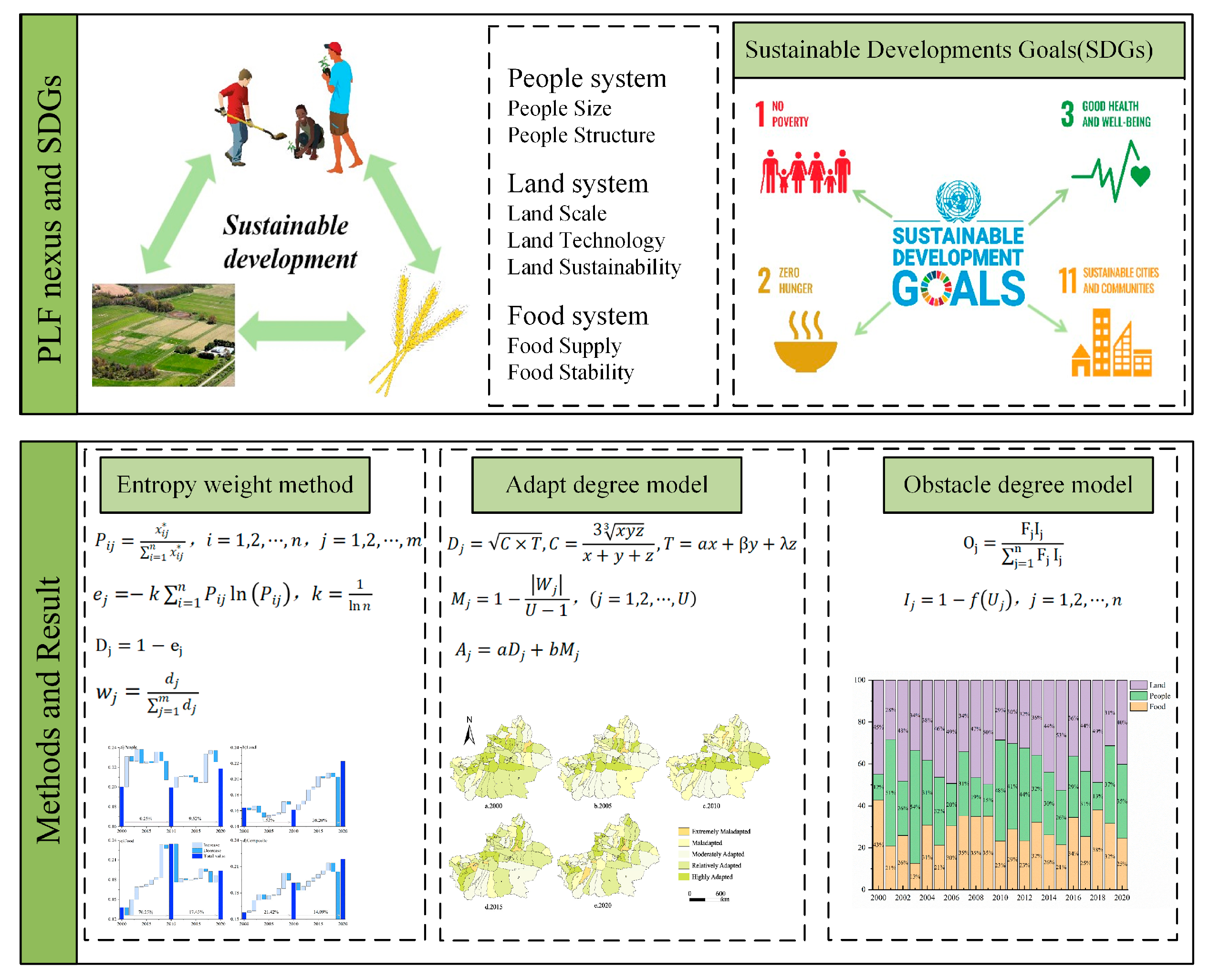
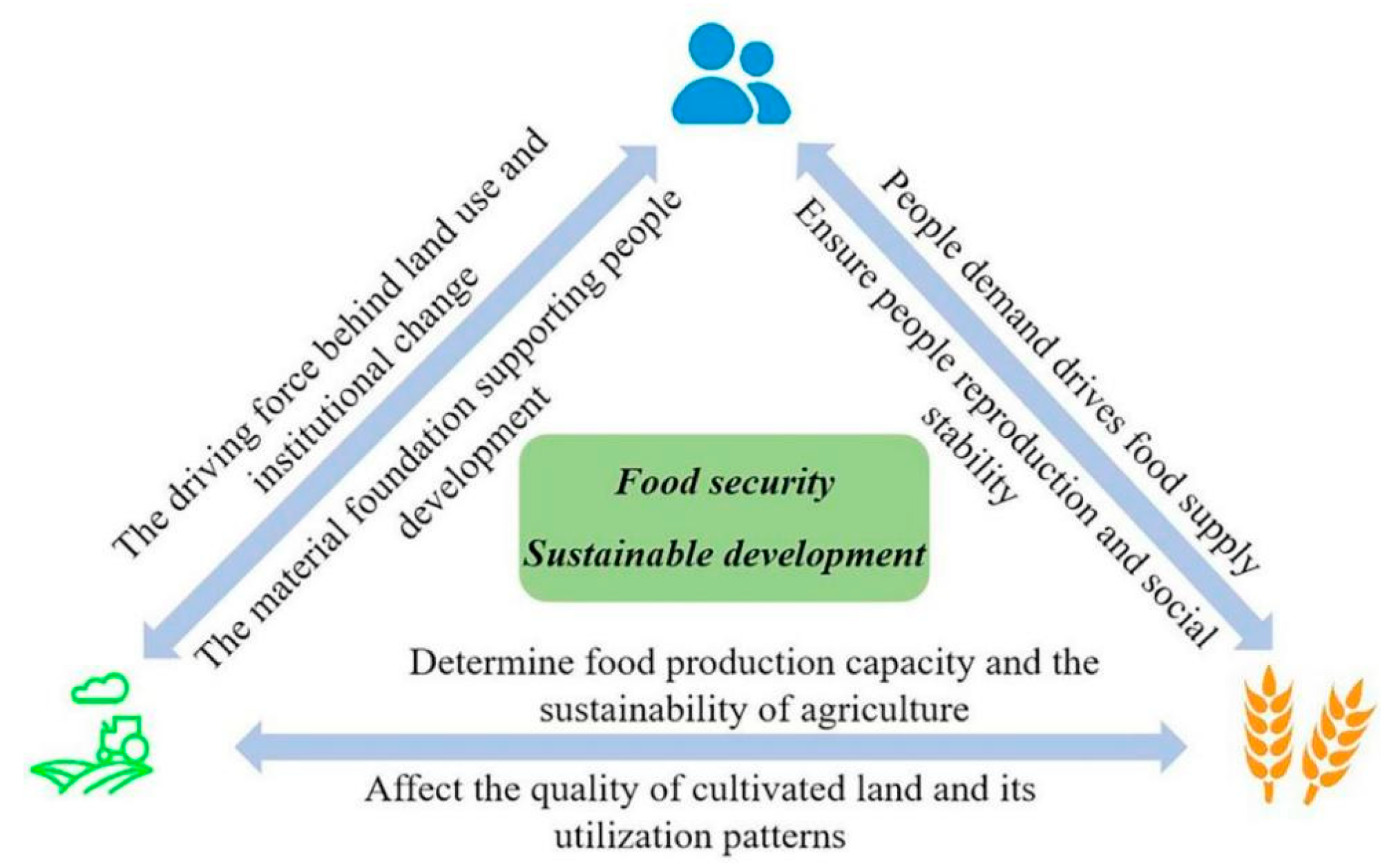
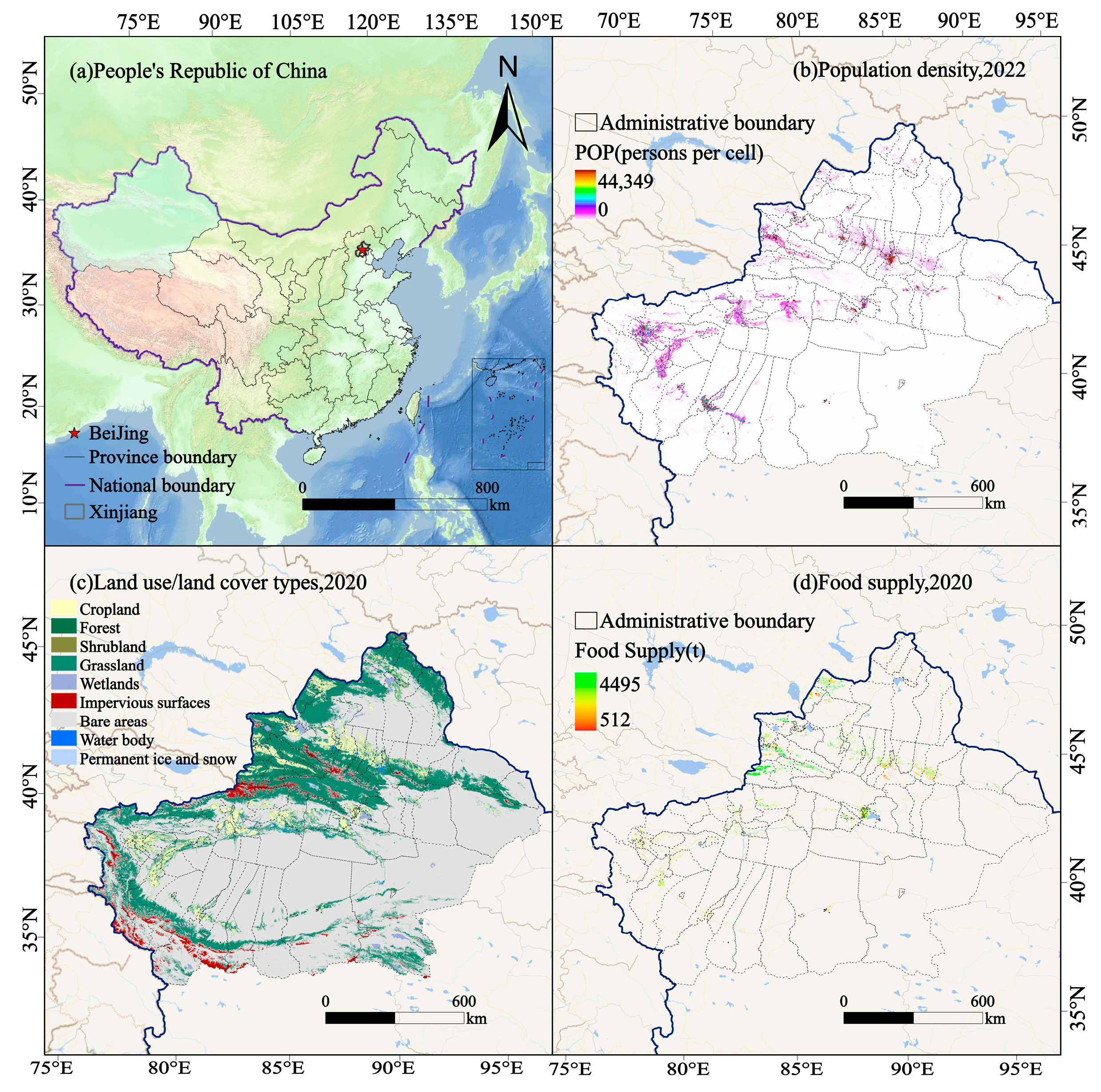



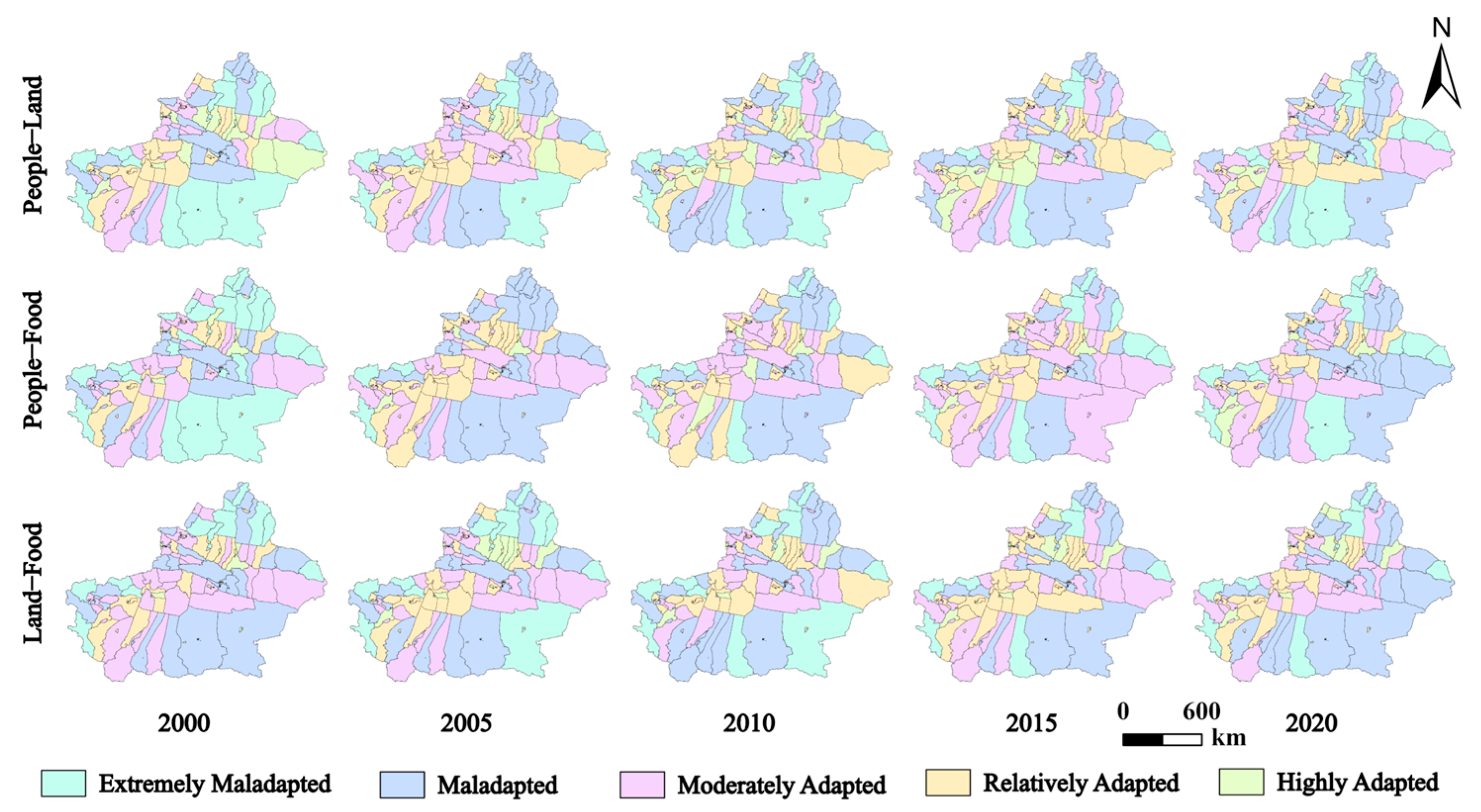
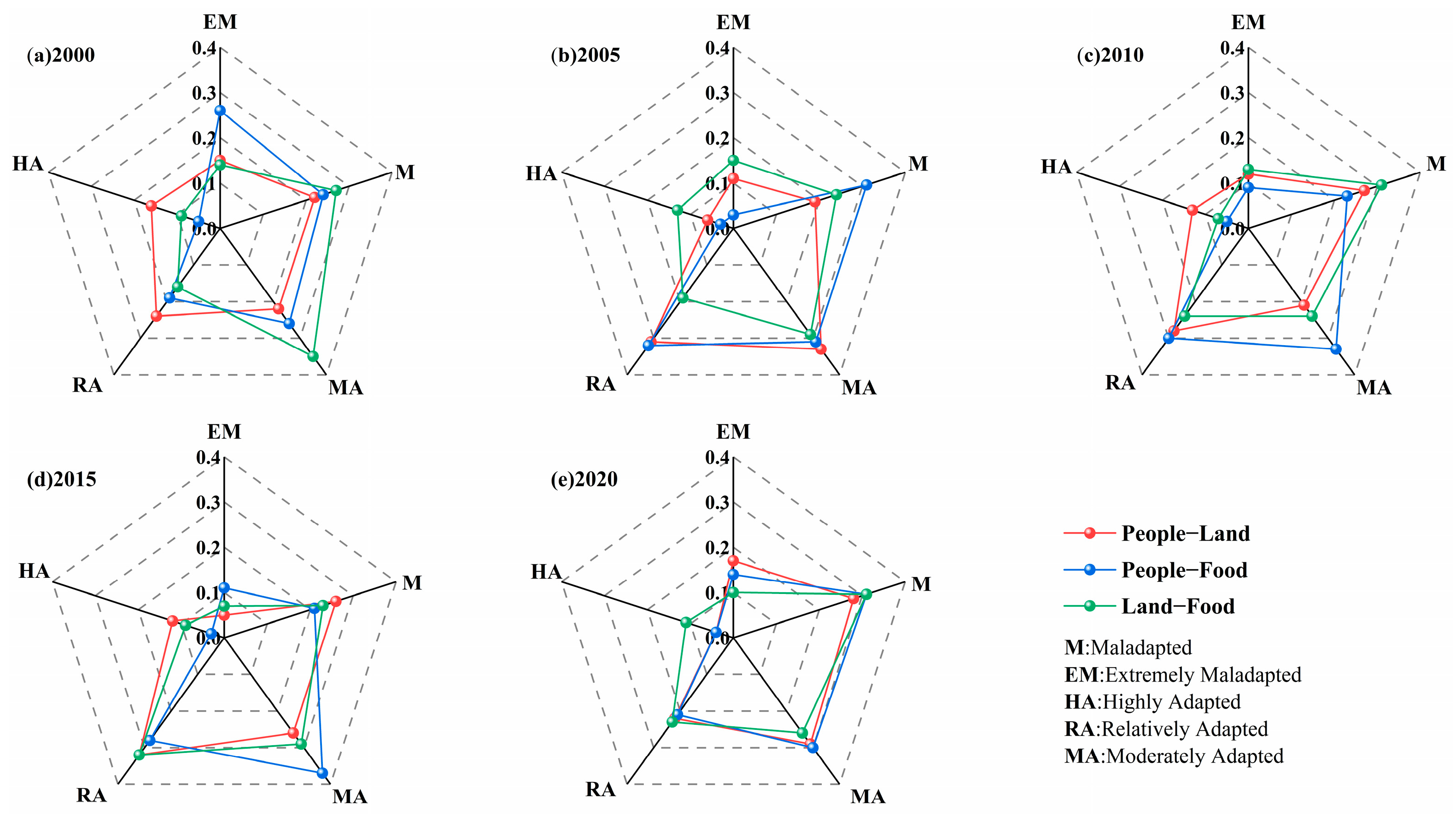

| Subsystem | Dimension | Indicator (Code) | Unit | Weights |
|---|---|---|---|---|
| People (A) | Population Size (A1) | Permanent Population at Year-End (A11) | thousands of people | 0.080 |
| Natural Population Growth Rate (A12) | ‰ | 0.029 | ||
| Population Structure (A2) | Proportion of Non-Agricultural Population (A21) | % | 0.034 | |
| Rural Workforce (A22) | thousands of people | 0.059 | ||
| Land (B) | Land Scale (B1) | Cultivated Land Area (B11) | km2 | 0.066 |
| Total Sown Area (B12) | km2 | 0.061 | ||
| Cropping Index (B13) | % | 0.026 | ||
| Land Technology (B2) | Total Agricultural Machinery Power (B21) | kW | 0.056 | |
| Agricultural Electricity Consumption (B22) | kWh | 0.148 | ||
| Land Sustainability (B3) | Agricultural Fertilizer Application (B31) | t | 0.094 | |
| Effective Irrigation Rate (B32) | % | 0.021 | ||
| Food (C) | Food Supply (C1) | Grain Yield per Unit Area (C11) | kg/ha | 0.025 |
| Five-Year Average Grain Yield (C12) | t | 0.076 | ||
| Food Stability (C2) | Grain Production Fluctuation Rate (C21) | % | 0.012 | |
| Proportion of Agricultural Output Value in Total Agricultural, Forestry, Animal Husbandry, and Fishery Output Value (C22) | % | 0.019 | ||
| Primary Industry Output Value (C23) | CNY | 0.075 | ||
| General Public Budget Expenditure (C24) | CNY | 0.120 |
| Year | Order | 1 | 2 | 3 | 4 | 5 | 6 |
|---|---|---|---|---|---|---|---|
| 2000 | Obstacle factors (OD%) | C11 (23) | B22 (18) | A11 (12) | C12 (9) | C23 (6) | A22 (5) |
| 2001 | Obstacle factors (OD%) | C24 (18) | C23 (18) | B31 (16) | B12 (12) | B21 (12) | A22 (6) |
| 2002 | Obstacle factors (OD%) | C23 (20) | C24 (16) | B31 (12) | B11 (9) | A11 (8) | B21 (7) |
| 2003 | Obstacle factors (OD%) | C24 (22) | B31 (14) | B22 (14) | B12 (9) | C12 (7) | C23 (6) |
| 2004 | Obstacle factors (OD%) | B21 (15) | C12 (13) | C24 (13) | B31 (12) | B22 (7) | A12 (7) |
| 2005 | Obstacle factors (OD%) | B22 (26) | A22 (12) | B12 (12) | B11 (8) | C24 (7) | A11 (7) |
| 2006 | Obstacle factors (OD%) | B31 (16) | C24 (13) | B22 (12) | B11 (9) | C23 (9) | A22 (7) |
| 2007 | Obstacle factors (OD%) | C24 (25) | A11 (21) | B21 (11) | A22 (10) | A12 (9) | B31 (6) |
| 2008 | Obstacle factors (OD%) | B22 (17) | B11 (17) | B12 (16) | C24 (10) | B13 (10) | C23 (9) |
| 2009 | Obstacle factors (OD%) | B12 (12) | B31 (12) | C24 (11) | B21 (10) | C12 (10) | B11 (9) |
| 2010 | Obstacle factors (OD%) | A11 (15) | C23 (13) | B12 (11) | B31 (10) | B22 (8) | B13 (7) |
| 2011 | Obstacle factors (OD%) | B22 (16) | C23 (12) | C12 (11) | B11 (9) | B21 (9) | B31 (8) |
| 2012 | Obstacle factors (OD%) | A22 (13) | B22 (12) | B11 (11) | A11 (10) | B32 (8) | C12 (7) |
| 2013 | Obstacle factors (OD%) | A11 (21) | B11 (15) | B12 (13) | C24 (8) | A21 (6) | B31 (6) |
| 2014 | Obstacle factors (OD%) | B22 (23) | C24 (22) | B21 (11) | A22 (7) | B31 (5) | C12 (5) |
| 2015 | Obstacle factors (OD%) | C12 (12) | B22 (12) | A11 (10) | B31 (9) | B11 (9) | C23 (9) |
| 2016 | Obstacle factors (OD%) | C24 (17) | A11 (13) | C23 (12) | B12 (11) | B31 (10) | B11 (8) |
| 2017 | Obstacle factors (OD%) | C24 (16) | C12 (15) | A11 (12) | B22 (11) | B12 (10) | A22 (10) |
| 2018 | Obstacle factors (OD%) | C24 (20) | A11 (10) | B12 (10) | C12 (10) | B31 (8) | B22 (7) |
| 2019 | Obstacle factors (OD%) | C24 (21) | A11 (13) | C23 (12) | A22 (10) | B22 (7) | C12 (5) |
| 2020 | Obstacle factors (OD%) | B31 (16) | C23 (14) | B12 (13) | B21 (10) | C24 (9) | A11 (6) |
Disclaimer/Publisher’s Note: The statements, opinions and data contained in all publications are solely those of the individual author(s) and contributor(s) and not of MDPI and/or the editor(s). MDPI and/or the editor(s) disclaim responsibility for any injury to people or property resulting from any ideas, methods, instructions or products referred to in the content. |
© 2025 by the authors. Licensee MDPI, Basel, Switzerland. This article is an open access article distributed under the terms and conditions of the Creative Commons Attribution (CC BY) license (https://creativecommons.org/licenses/by/4.0/).
Share and Cite
Zhang, X.; Kasimu, A.; Zhang, Y.; An, X.; Song, N.; Shayiti, B. Development Path of the People–Land–Food Complex System in Xinjiang from the Dual Perspectives of Adaptability and Obstacle Degree. Land 2025, 14, 2310. https://doi.org/10.3390/land14122310
Zhang X, Kasimu A, Zhang Y, An X, Song N, Shayiti B. Development Path of the People–Land–Food Complex System in Xinjiang from the Dual Perspectives of Adaptability and Obstacle Degree. Land. 2025; 14(12):2310. https://doi.org/10.3390/land14122310
Chicago/Turabian StyleZhang, Xue, Alimujiang Kasimu, Yan Zhang, Xueyun An, Ning Song, and Buwajiaergu Shayiti. 2025. "Development Path of the People–Land–Food Complex System in Xinjiang from the Dual Perspectives of Adaptability and Obstacle Degree" Land 14, no. 12: 2310. https://doi.org/10.3390/land14122310
APA StyleZhang, X., Kasimu, A., Zhang, Y., An, X., Song, N., & Shayiti, B. (2025). Development Path of the People–Land–Food Complex System in Xinjiang from the Dual Perspectives of Adaptability and Obstacle Degree. Land, 14(12), 2310. https://doi.org/10.3390/land14122310









